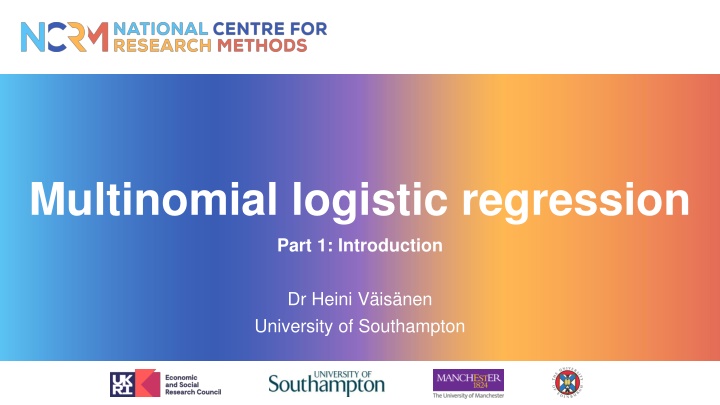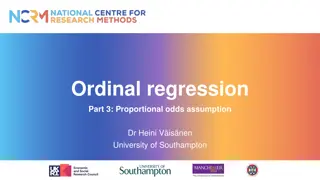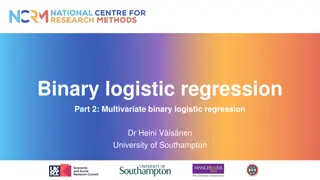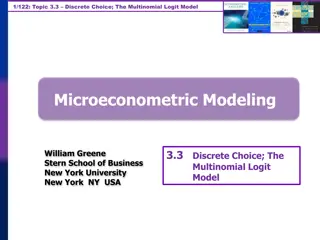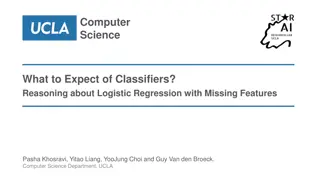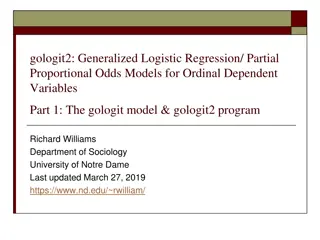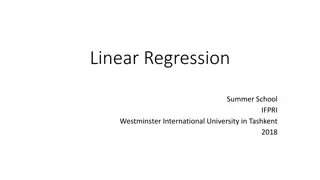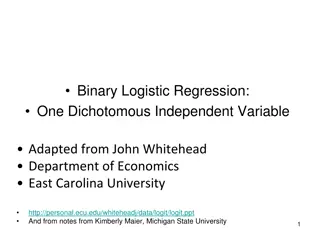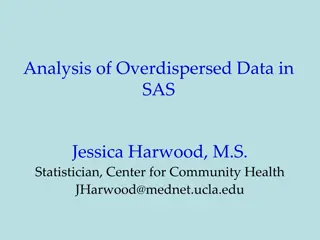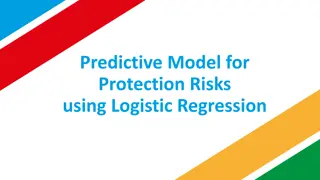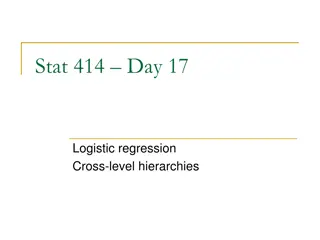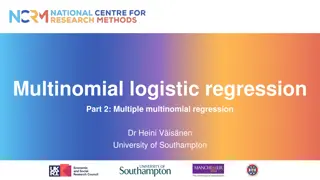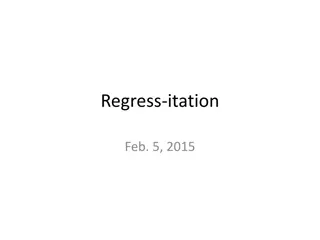Introduction to Multinomial Logistic Regression by Dr. Heini V. at University of Southampton
This content introduces Multinomial Logistic Regression, discussing categorical response variables, the basics of the model, interpretation of parameters, and an example study on economic activity and gender. It covers the extension of binary logistic regression to multiple categories, interpretation of log-odds models, and choosing reference categories. The association between economic activity and gender is explored with data tables showing the distribution of variables.
Download Presentation

Please find below an Image/Link to download the presentation.
The content on the website is provided AS IS for your information and personal use only. It may not be sold, licensed, or shared on other websites without obtaining consent from the author.If you encounter any issues during the download, it is possible that the publisher has removed the file from their server.
You are allowed to download the files provided on this website for personal or commercial use, subject to the condition that they are used lawfully. All files are the property of their respective owners.
The content on the website is provided AS IS for your information and personal use only. It may not be sold, licensed, or shared on other websites without obtaining consent from the author.
E N D
Presentation Transcript
Multinomial logistic regression Part 1: Introduction Dr Heini V is nen University of Southampton
Outline Categorical response variables Multinomial logistic regression model Interpretation of parameters Example: a study of economic activity
Categorical response variables Often we have a categorical response Y with R 3 (unordered) categories. Examples of such outcomes: Voting intention (Conservative, Labour, Liberal Democrats, or other). Cause of death (e.g. different types of cancer)
Multinomial logistic regression: the basics Idea: Extension of (binary) logistic regression use separate logit model for each pair of response categories. If Y has R categories, there are R(R-1) possible pairwise log-odds. However, we only need R-1 of these. For 3 categories, 3*(3-1)=6 possibilities (1,2 1,3 2,3 2,1 3,1 3,2) but we only need to model two pairs.
Multinomial logistic regression: interpretation Interpretation of any log-odds model depends on which response corresponds to the numerator and the denominator The category corresponding to the denominator is called the reference or baseline category and is usually: the first or last category the most meaningful category the most frequent category not a rare category
Multinomial logistic regression: interpretation For a single explanatory variable X: 1 3 2 3 and log log = ?1+ ?1? = ?2+ ?2? Which outcome category (1-3) is the reference category here?
Example: the association between economic activity and gender Outcome economic activity has three categories 1. Economically inactive 2. Unemployed 3. In employment Our explanatory variable has two categories 1. Man 2. Woman
Distribution of the variables Employment status N % Gender N % 442 39.32 516 45.91 Economically inactive Man 55 4.89 608 54.09 Unemployed Woman 627 55.78 In employment Total 1,124 100.0 Total 1,124 100.0 Data source: University of Manchester. Cathie Marsh Centre for Census and Survey Research. ESDS Government, ONS Opinions Survey, Well-Being Module, April 2011: Unrestricted Access Teaching Dataset [computer file]. 2nd Edition. Office for National Statistics. Social Survey Division, [original data producer(s)]. Colchester, Essex: UK Data Archive [distributor], October 2012. SN: 7146.
Interpretation of the parameters Model: log( 1/ 3)= 1 + 1X log( 2/ 3)= 2 + 2X 1 is the effect of X on the log-odds of being in category 1 instead of category 3, i.e. binary outcome either 1 or 3. 2 is the effect of X on the log-odds of being in category 2 instead of category 3, i.e. binary outcome either 2 or 3. Odds ratios can be obtained by calculating exp( 1) and exp( 2) The baseline is category 3 (in employment the most frequent category).
Economic activity and gender, interpretation (odds) The odds of being economically inactive rather than in employment are 73% higher for women than for men. (exp(0.550)-1)*100 = 73.3% The odds of being economically inactive rather than in employment are 42% lower for women than for men. (exp(-0.537)-1)*100 = -41.6%
Economic activity and gender, interpretation (probabilities) exp(?1+ ?1?) ?1= 1 + exp ?1+ ?1? + exp(?2+ ?2?) exp(?2+ ?2?) ?2= 1 + exp ?1+ ?1? + exp(?2+ ?2?) 1 The reference category ?3= 1 + exp ?1+ ?1? + exp(?2+ ?2?)
Economic activity and gender, interpretation (probabilities for women) log( 1/ 3) = -0.659 + 0.550X Economically inactive log( 2/ 3) = -2.204 - 0.537X Unemployed exp( 0.659 + 0.550?) ?1= 1 + exp 0.659 + 0.550? + exp( 2.204 + 0.537?)= 0.46 exp( 2.204 + 0.537?) ?2= 1 + exp 0.659 + 0.550? + exp( 2.204 + 0.537?)= 0.03 1 ?3= 1 + exp 0.659 + 0.550? + exp( 2.204 + 0.537?)= 0.51
Economic activity and gender, interpretation (probabilities) Among women, the probability of being economically inactive was 46%, in employment 51% and unemployed 3%. Among men, the probability of being economically inactive was 32%, in employment 61% and unemployed 7%.
